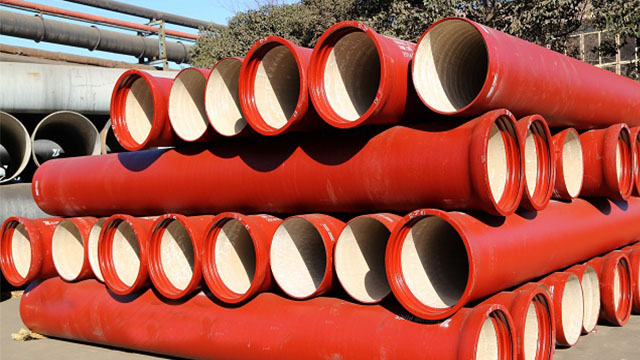Uncover the Secret: How the Right Ductile Iron Pipe Diameters Maximize Water Supply Efficiency
2025-03-14 16:04:14 hits:0
You might be surprised to learn that a staggering amount of water is wasted each year due to incorrect ductile iron pipe diameters. In the world of water supply systems, the diameter of the pipes plays a far more crucial role than most people realize. This article aims to uncover the secrets behind how the right ductile iron pipe diameters can maximize water supply efficiency.

Ductile Iron Pipe Diameters in Different Water Supply Networks
Ductile iron pipes are used in diverse water supply networks, each with unique diameter requirements.
Municipal water supply networks, serving large populations, often use larger - diameter pipes. Main transmission pipelines in a city may have diameters ranging from 300mm to 1200mm or more. Larger diameters ensure high flow rates, reducing pressure loss over long distances and providing adequate water pressure across the service area. If you want to explore our ductile iron pipes suitable for municipal projects, click here.
Rural water supply networks, catering to smaller, scattered populations, have variable diameter needs. Small - diameter pipes (50mm - 200mm) may be sufficient in some cases, while areas with significant agricultural or industrial water use may require larger diameters.
Private water supply networks, like those in residential buildings or industrial plants, also have specific diameter considerations. A single - family home may use a 25mm - 50mm pipe, while commercial or industrial facilities with high water consumption typically need 100mm - 300mm diameters. To find out more about our products for private water supply, visit our product page.
Understanding these differences is key to optimizing water supply efficiency.
The Impact of Diameter on Water Quality and Quantity
The diameter of ductile iron pipes significantly impacts both water quality and quantity.
For water quantity, larger - diameter pipes allow for greater water flow per unit time. Their larger cross - sectional area offers less resistance to flow. In high - demand systems, choosing the right large diameter ensures sufficient water supply. Conversely, undersized pipes lead to reduced flow rates, long waiting times, and pressure drops.
In terms of water quality, larger - diameter pipes may have longer water residence times, potentially promoting microbial growth if water quality isn't well - maintained. Smaller - diameter pipes, with higher flow velocities, can prevent sediment deposition and biofilm formation. However, overly high velocities may erode pipe walls.
The diameter also affects water treatment processes. In larger - diameter pipes, uniform disinfectant distribution can be challenging, increasing the risk of waterborne diseases.
Advanced Tools for Diameter Calculation
There are several advanced tools for accurately calculating ductile iron pipe diameters.
Hydraulic calculation software, such as EPANET, uses complex hydraulic principles. By inputting factors like water demand, pipe length, elevation differences, and friction coefficients, engineers can precisely determine the required diameter for optimal water flow and pressure.
Online calculators are user - friendly. They need basic inputs like expected flow rate, pipe length, and allowable pressure drop to quickly estimate the appropriate diameter. Some even compare different pipe materials.
3D modeling software enables engineers to create virtual water supply system models. Visualizing in 3D helps understand how diameters affect the layout and system performance under various scenarios.
Real - World Success Stories
Case 1: A Commercial Complex Transformation
A large commercial complex faced inconsistent water pressure and insufficient supply during peak hours. The existing pipes were too small for the high water demand. After our team's assessment, we recommended upgrading key section pipes from 80mm to 150mm. The results were remarkable: stable water pressure, resolved supply issues, and reduced energy consumption for pumping. If you're a commercial property owner facing similar issues, contact us for solutions.
Case 2: An Industrial Plant's Upgrade
An industrial plant suffered from high water wastage and inefficiencies due to non - optimized pipe diameters. Our customized solution involved replacing some pipes with better - sized ones, increasing diameters from 100mm to 200mm in some areas. Water wastage decreased by about 30%, and the overall water supply efficiency improved significantly.
Case 3: A Residential Community's Improvement
A residential community had slow water flow and long hot - water waiting times because of small - diameter pipes. After analyzing water usage data, we recommended upgrading main supply pipes from 50mm to 100mm. Residents noticed faster water flow and shorter waiting times.
Conclusion and Call for Action
The diameter of ductile iron pipes is crucial for water supply efficiency. Incorrect diameters cause problems, while the right choice, based on a full understanding of network requirements, water quality and quantity impacts, and using advanced tools, can lead to significant improvements.
If you're involved in water supply projects, don't let wrong diameters hamper efficiency. Our company offers professional expertise and high - quality ductile iron pipes. Explore our product range here or contact us for personalized advice. Let's optimize water supply efficiency together.

 en
en  fra
fra  de
de  ru
ru  gle
gle  th
th  ara
ara  it
it  jp
jp  kor
kor  zh
zh 


